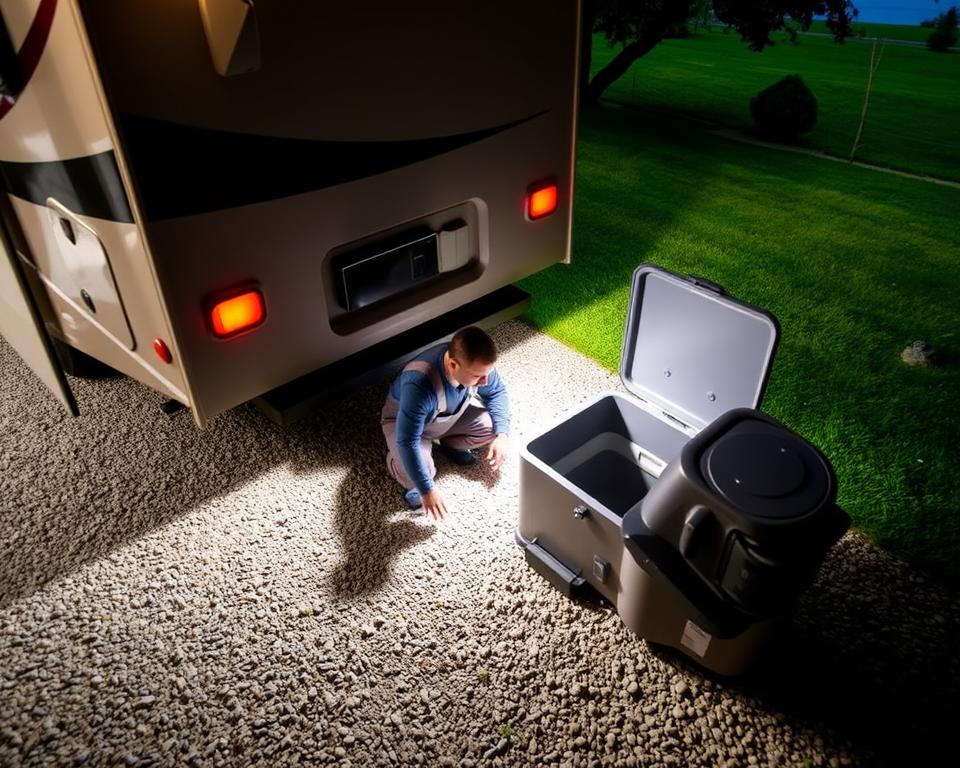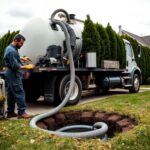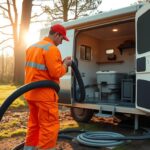Enhance Your RV’s Water Setup Using a Pressure Tank
Have you thought about the impact of an RV pressure tank on your camping trips? While journeying, your RV’s plumbing system becomes vital for daily activities like bathing and dishwashing. Fine-tuning this system ensures a consistent and dependable water flow, vital on the road. We’ll examine how an RV pressure tank can improve your onboard water system – RV tank pumping service near me, improving comfort during your adventures.
Critical Findings
- A camper pressure tank boosts flow on the move.
- Dependable pressure matters for routine use.
- Optimizing your RV water system increases comfort while camping.
- Pressure vessels ensure even delivery.
- Enhanced delivery benefits every fixture.
The Value of Consistent Water Pressure in Your RV
Consistent plumbing is key to enjoyable RV trips. It ensures daily tasks like showering, washing dishes, and using the toilet are smooth. Issues like low water pressure can impede these activities, highlighting the necessity of proper water flow in your RV.
Low water pressure can stem from multiple problems. Leaks, clogged filters, or insufficient water supply are common causes. Not only do these problems interfere with convenience, but they can also escalate into larger issues without timely intervention. Thus, regular upkeep is essential for a well-functioning RV plumbing system.
Important aspects of maintaining a dependable RV water system include:
- Inspecting all fittings and lines for drips
- Flushing or swapping out blocked filters
- Using a pressure limiter to prevent spikes
Keeping these practices top of mind empowers RV owners to enhance their water flow. It makes the camping experience enjoyable.

What is an RV Pressure Tank?
An RV pressure tank plays a crucial role in a recreational vehicle’s water system. It ensures water pressure remains even and dependable. This component stores and buffers water, making it available even when demand peaks. It prevents the inconvenience caused by pressure drops.
The design of an RV water pressure tank often incorporates a bladder or diaphragm. This mechanism separates water from air, allowing for swift pressurization. Recognizing the function of a camper pressure tank works empowers RV owners to manage their plumbing. A quality motorhome pressure tank boosts water delivery’s reliability and efficiency.
The Way a Pressure Tank Improves Water Delivery
An RV pressure tank plays a crucial role by providing consistent water flow. It prevents interruptions when multiple water sources are used at once. When faucets, showers, and toilets operate together, a pressure tank keeps the supply steady.
This tank takes the load off the pump system, leading to higher efficiency. It stores pressurized air, pushing water through the system. This action means the water pump runs fewer cycles. The result? Saved energy and an extended water pump life.
Thanks to these tanks, RV owners enjoy dependable water flow, enhancing their experience. No more weak streams or pauses. Understanding its operation helps you sidestep flow issues.
| Feature | Advantage |
|---|---|
| Consistent Pressure | Enhances overall water flow, improving usability |
| Less Pump Cycling | Lowers energy consumption and extends pump life |
| Quick Water Delivery | Ensures water is ready across multiple outlets |
| Easy Installation | Makes retrofits straightforward |
Benefits of Installing a Recreational Vehicle Pressure Tank
Adding a pressure vessel delivers multiple benefits. It leads to consistent water pressure, enhancing showering, cooking, and cleaning experiences. The absence of sudden water flow drops allows for fluid operation.
It also eases strain on the pump. By maintaining steady pressure, the tank extends the pump’s lifespan and cuts down on repair needs. This results in significant maintenance cost savings and less inconvenience over time.
Efficient water use is also a major plus. It helps avoid common pressure-related problems like leaks. These tanks boost plumbing system reliability, ensuring hassle-free trips. With proper setup and maintenance, they bring confidence and peace of mind.
How to Select the Best Pressure Tank
Choosing the correct RV pressure tank requires thought on many aspects to match your RV water system’s needs. Start by evaluating size. RV pressure tanks vary in size; knowing how much water you use will help pick the right one.
The tank’s material significantly impacts durability. Tanks made of stainless steel or polyethylene offer superior toughness. It’s crucial to select a tank that fits your needs and endures travel.
Diaphragm tanks stand out when considering options. They smooth out surges and protect pipes. Checking model specifications ensures compatibility with your system.
Getting advice from RV experts is beneficial. They ensure the tank works well with your RV’s plumbing, so you get a setup that runs flawlessly.
Installing Your Camper’s Pressure Tank
Fitting a tank transforms your plumbing performance. It’s important to be thorough and follow plumbing best practices. Start by picking the right spot for future maintenance.
Next, fasten the supply and return lines tightly. Make sure everything is leak-free. A key part is checking the precharge level, which is essential for optimal performance.
If you’re not confident in your installation skills, seek professional help, like those at All in Sanitation. Their expertise ensures correct setup, boosting your system’s flow and reliability. Always adhere to manufacturer guidelines for best results and durability.
| Steps for Installation | Notes |
|---|---|
| Select Location | Pick a convenient spot with easy access |
| Attach Lines | Secure inlet and outlet to avoid leaks |
| Verify Precharge | Match manufacturer specs for best performance |
| Adhere to Guidelines | Stick to install instructions exactly |
| Seek Professional Help | Ensure proper setup |
How to Care for Your Pressure Tank
To maximize lifespan, maintain regularly. Monthly leak inspections are critical to prevent water waste and ensure air pressure settings are correct. Additionally, check and clean filters regularly.
A clear filter keeps water moving freely. An annual review is advisable to assess the tank’s performance and the associated plumbing. Documenting maintenance makes tracking easier.
By keeping your system in top shape, you ensure a consistent water supply, contributing to comfort and convenience on your journeys.
| Task | Frequency | Description |
|---|---|---|
| Check for Leaks | Monthly | Look for drips or moisture |
| Precharge Inspection | Monthly | Ensure the bladder’s air pressure matches specs |
| Water Filter Cleaning | Quarterly | Keep pathways clear |
| Yearly Service | Annually | Assess tank and plumbing health |
Advanced Pressure-Enhancing Techniques
Smart habits raise your system’s efficiency. A water pressure regulator is vital, as it maintains steady flow and prevents damage from pressure surges.
Avoid running multiple outlets at once. Prioritize needs, for example, don’t run shower and dishwasher together.
Quick showers help stabilize flow. This conserves water and stabilizes pressure, improving overall performance.
Keeping the water filter clean is crucial. Don’t let debris choke your system. Regular maintenance ensures optimal performance.
Inspect the bypass valve often. Proper valve operation supports efficient flow, boosting the camper’s water system.
| Tip | What to Do | Benefit |
|---|---|---|
| Water Pressure Regulator | Prevent spikes | Keeps stress off fixtures |
| Limiting Fixture Use | Avoid simultaneous outlets | Reduces system overload |
| Quick Rinses | Reduce time spent in the shower | Stops pressure from dropping |
| Clean Water Filter | Ensure the filter is free from debris | Prevents clogs |
| Valve Inspection | Test the bypass valve | Supports smooth flow |
To Summarize
Recognizing the significance of the RV pressure tank is vital for enhancing your RV water system. It ensures a constant water flow and adequate pressure, improving your road experiences. This dependability turns camping into comfortable, enjoyable adventures.
For optimal benefits, it’s essential to correctly install and maintain your pressure tank. Routine checks prevent flow hiccups. Implementing water pressure strategies further ensures a flawless system.
Applying these tips guarantees worry-free water use. You can enjoy your time outdoors without concerns over water quality or supply. Enjoy your journeys with peace of mind!

